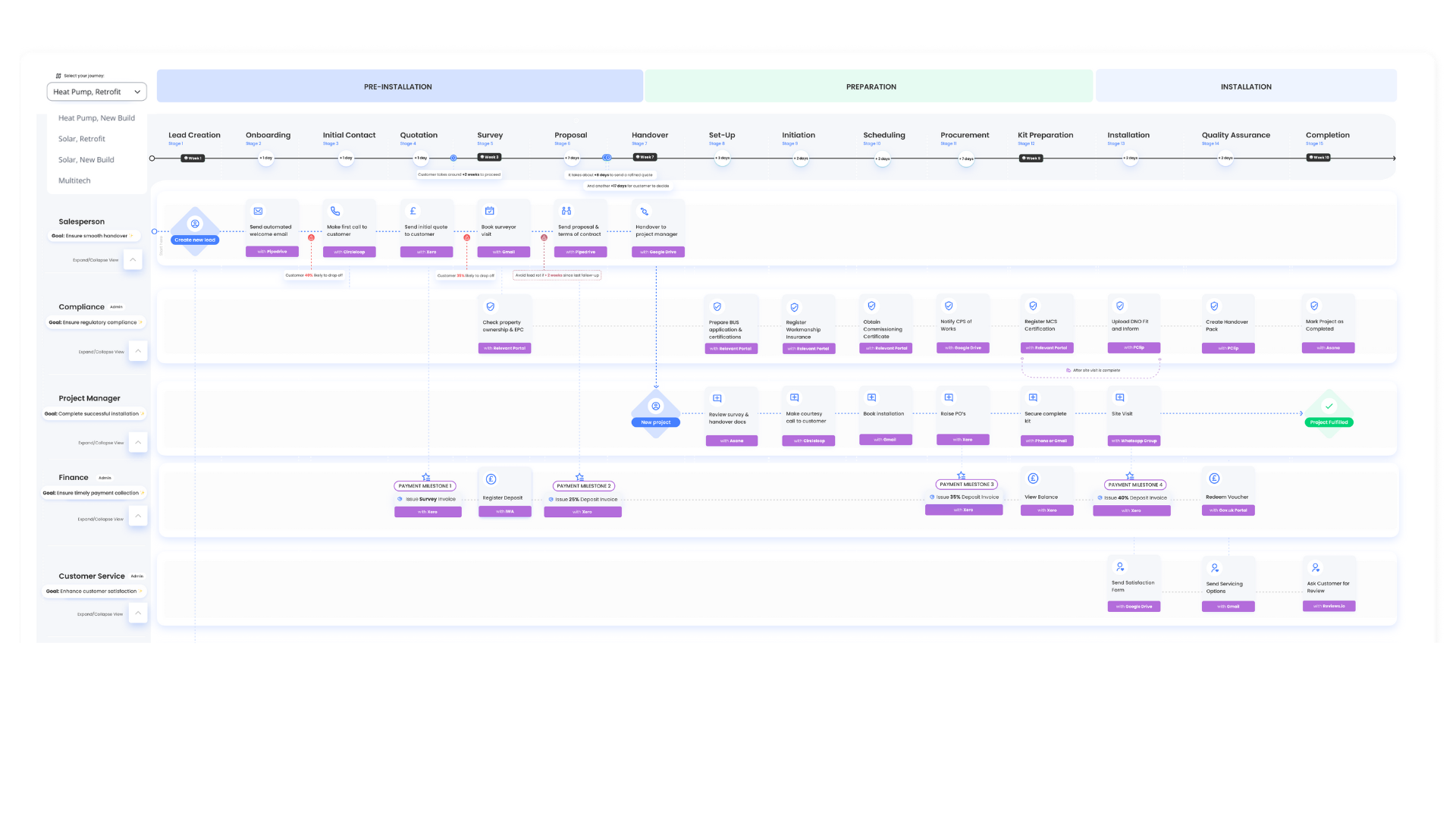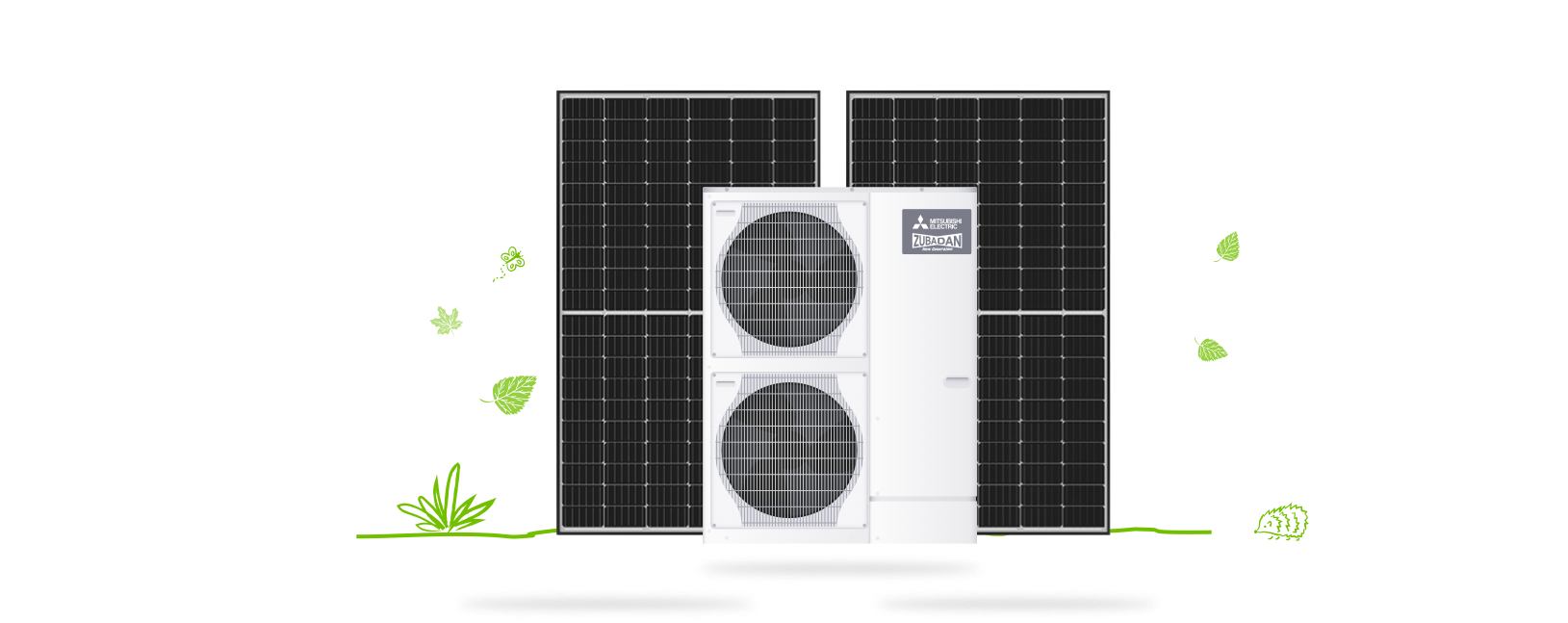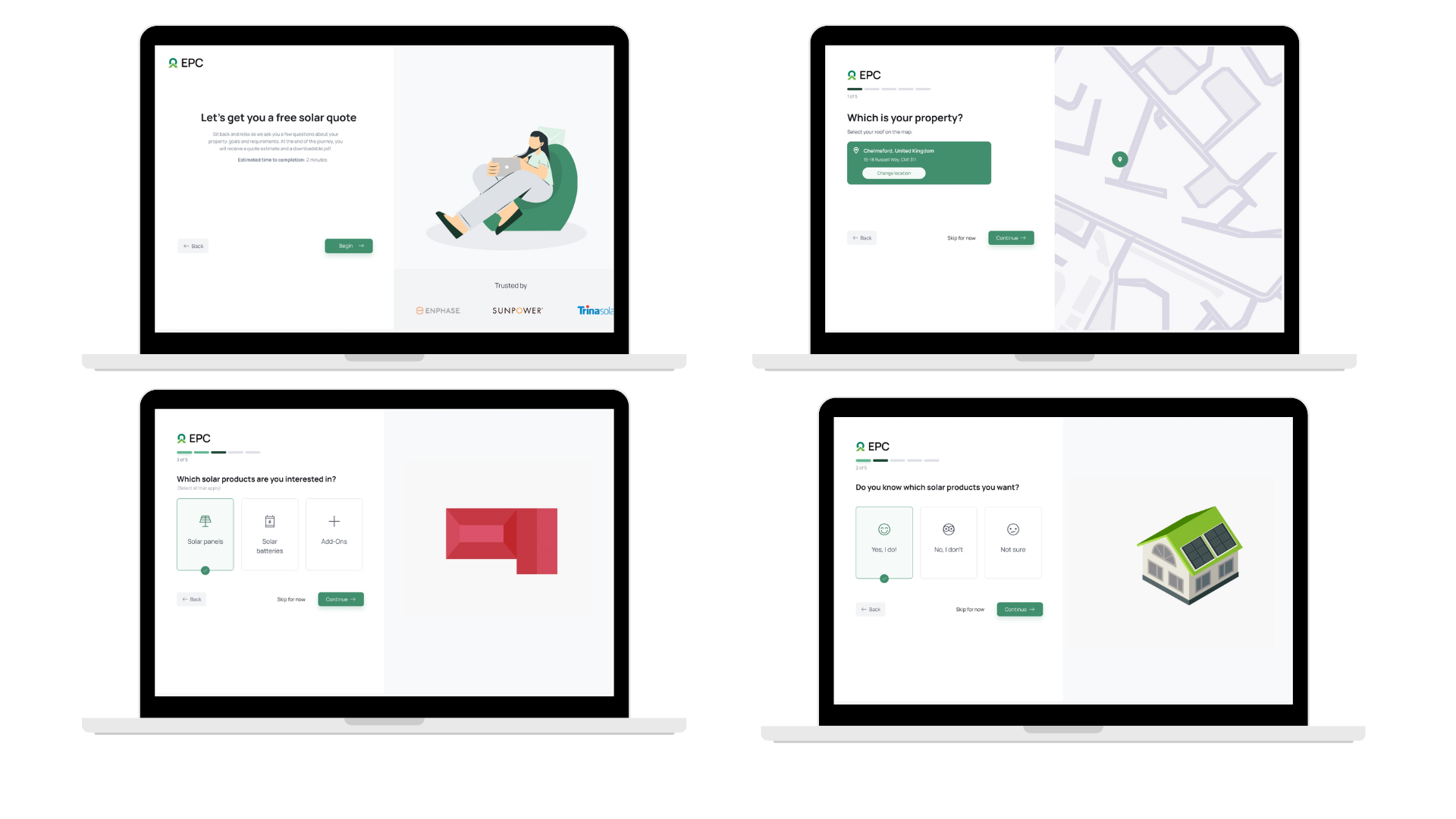
EPC: Make Renewable Energy Friendly
Driving Digital Transformation in Renewable Energy
End-to-end platform design, CRM, mobile, tablet, desktop
+ marketing & branding 🪄



The Vision
EPC sought to develop an integrated office and field management platform that connects customers, installers, surveyors, design teams, administrative staff, sales, and project managers. The ultimate vision was to launch this as a scalable SaaS offering. To achieve this, EPC brought in a UX designer to lead the research, ideation, design, and build phases, as well as to guide its growth.
Who is EPC?
EPC Improvements, founded in 2017, is a renewable energy installation company serving the greater Essex area. They specialise in both residential and commercial installations of heat pumps, solar panels, MVHR, underfloor heating, and other sustainable technologies.
They pride themselves on a no 'salesman' type approach and help customers access government funded grants that ensure they provide the most cost effective solution to meet “Minimum Energy Efficiency Standard (MEES) Regulations”.
Table A: EPC’s Product Service Offering grouped in four categories: Extraction of Energy, Energy Conversion, Energy Storage and Energy Distribution.
Table B: EPC’s Product Service Offering orbit which includes it’s specific offerings, in residential and commercial contexts.

Our Objectives
Unified & Streamlined User Experience: Create an end-to-end journey that unifies all users, from initial customer inquiry to post-installation support.
Enhanced Customer Engagement with AR: Implement Augmented Reality (AR) to help customers visualize how products like heat pumps and solar panels would fit into their homes.
Efficient Workflow Integration: Develop an integrated platform that supports the entire process—from sales inquiries to installation and aftercare.
Launch as SaaS Platform: Build a scalable digital solution that could expand as EPC grows into new markets.


Strategic Research and Discovery
The first step was getting to know EPC's stakeholders and users, both internal and external. I wanted to understand what they needed from the platform. The research phase involved auditing current workflows, talking to different internal teams, and getting insights from subcontractors.
During the research and discovery phase, I organised cross-functional (XFN) workshops to evaluate solution ideas and keep everyone aligned—engineering, sales, operations, and others. These sessions helped make sure that the proposed solutions were realistic and that every department was on the same page.
I worked closely with various teams to create detailed roadmaps and map out existing processes. This was key to spotting workflow bottlenecks and fine-tuning the platform's features to make the user experience smoother.
I ran focus groups with 35 participants and conducted “express user interviews” with subcontractors to better understand what was holding people back from adopting renewable energy. We dug into their pain points and looked for ways to make the customer journey simpler and more engaging.
To make sure the platform met users' needs, I held feedback sessions with relevant users. Their input was crucial for refining the features and solving real challenges they faced.


Our Research Questions
We also developed key research questions to guide our approach:
Assess Customer Perceptions of AR: Evaluate how AR could improve customer understanding and engagement.
Determine AR Features with Highest Impact: Identify which AR functionalities (e.g., visualisations, guided tutorials) resonate most with users.
Evaluate Cross-Functional Needs: Address the specific challenges of each role within EPC, ensuring the platform is effective and intuitive for all users.
Adapt Design for Tech-Savviness: Tailor user interfaces to accommodate varying levels of technological familiarity among customers and field staff.

Key Research Findings
Customer Needs: Customers found it difficult to visualise EPC’s products, such as heat pumps, in their homes, leading to indecision. AR was identified as a potential solution for enhancing customer comprehension and engagement.
Project Management Requirements: Project managers needed a consolidated dashboard to track project timelines, handle RFIs, and communicate effectively with installers and surveyors.
Field Challenges: Installers required a clear, structured guide for installations to maintain quality and consistency across projects, while surveyors highlighted the need for offline-capable tools for accurate data collection in the field.
Administrative Flexibility: Admins required a flexible interface to manage user roles and permissions, given the cross-departmental nature of EPC’s projects.




Market Research
With marketing and branding central to my role, I used a range of tools for an in-depth market and competitive analysis. I started by reviewing policy and legislation sources like the IEA and CREDS and gathered data insights from platforms like Pipedrive and Google Analytics.
For competitor benchmarking, I conducted a web audit, studying companies such as OVO and Boxt, and analyzed user feedback through EPC’s reviews on platforms like Reviews.io and Google. This approach helped me understand the incentives driving user engagement—such as cost savings and sustainability—and guided my design to address user needs while keeping the product competitive.

User Personas and Stories
Based on the research, I developed user personas and stories to guide the design:
Customer Persona: Emily is an environmentally conscious homeowner who wants to see how products will look before making a decision.
User Story: "I want to see how solar panels or heat pumps will look in my home so I can feel confident in my purchase."
Project Manager Persona: Oliver is a project manager who oversees multiple renewable energy installations.
User Story: "I need a simple way to manage timelines, assign tasks, and communicate effectively with my team."
Installer Persona: Jack is a field technician who needs straightforward guidance in his work.
User Story: "I need a clear, step-by-step checklist for installations to make sure everything is done right."
Admin Persona: Sarah handles user access and needs efficient ways to streamline workflows.
User Story: "I want to easily assign roles and manage permissions to make sure everyone has the right access."

Experience and Process Mapping
To make sure the platform was truly user-focused, I created an experience map that broke down the customer journey into three main phases: Project Initiation, Installation, and Post-Installation. Each phase highlighted the specific needs and responsibilities of different roles:
Customers: We prioritised ease of use and transparency, allowing them to visualise heat pump installations, schedule appointments, and receive real-time updates.
Surveyors: We designed a digital survey form to boost efficiency, featuring photo uploads, offline capabilities, and geolocation tagging for precise field data.
Project Managers: They needed a centralised view of project progress, task assignments, and communication tools to minimise bottlenecks.
Installers: For field technicians, we provided AR-based guidance with a checklist and navigation integration to keep installations accurate and on schedule.
Salespeople: Equipped with AR tools, they could better demonstrate product benefits, making it easier for customers to understand and decide.
Admins: We gave them comprehensive control over user roles, permissions, and workflows to keep the system running smoothly.


Understanding User Needs: I conducted thorough research to understand the specific needs and pain points of each department, particularly the PM team. This involved user interviews, workflow analysis, and observation of existing processes.
Experience Mapping: I visualised the user journey for each department, paying close attention to:
Triggers: What initiates each stage in the workflow?
Connections: How do different departments interact within the system?
Time Durations: How long does each stage typically take? This helped identify bottlenecks and areas for improvement.
Wireframing & Prototyping: Based on the refined experience maps, I created detailed wireframes for the expanded CRM, focusing on a user-friendly interface that addressed the specific needs of each department. I then developed interactive prototypes to test and refine the proposed solution.
CRM Tool Scope Expansion



The Design Process
My initial focus was on creating a basic framework for the platform. This involved developing low-fidelity wireframes of key features such as dashboards, project management modules, and AR visualisations. These wireframes served as a starting point for gathering user feedback and iteratively improving the design. The next step involved translating these wireframes into high-fidelity prototypes that could be tested with users. These prototypes were refined based on feedback from focus groups, ensuring the final design was both usable and effective in meeting user needs.






Design Exploration
Predictive Heat Map Analysis: Heat maps were used during testing to identify high-engagement areas, ensuring critical information was prioritised.
Colour & Typeface
Part of our rebranding initiative.

KPIs for the MVP
To measure the success of the UX/UI improvements, the following KPIs were established:
Project Efficiency: Aim to reduce the average time spent per project by 10% within three months of launch.
Communication Reduction: Decrease the volume of emails and clarification requests from project managers to installers, reducing administrative workload.
Customer Queue Growth: Increase the number of customers in the queue, either through enhanced profitability or streamlined operations.
These KPIs will help gauge the platform’s effectiveness in improving operational efficiency and user satisfaction.















